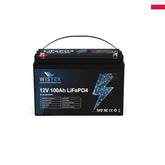Was ist die Mindestspannung für eine Golfwagenbatterie? Ein umfassender Leitfaden
Um Ihren Golfwagen zuverlässig und sicher mit Strom zu versorgen, ist es wichtig, die niedrigste sichere Spannung für Golfwagenbatterien zu kennen. Ob Golfbegeisterter, Flottenmanager oder jemand, der einen Golfwagen als persönlichen Transport nutzt: Das Erkennen von Spannungsschwellen kann die Batterielebensdauer verlängern, Schäden vermeiden und eine gleichbleibende Leistung gewährleisten. Dieser Leitfaden erläutert die technischen und praktischen Aspekte der Spannung von Golfwagenbatterien und gibt Ihnen praktische Tipps für die effiziente Wartung.
- Warum die Spannung bei Golfwagenbatterien wichtig ist
- Gängige Arten von Golfwagenbatterien und ihre Spannungsbereiche
- Was passiert, wenn die Mindestspannung der Golfwagenbatterien unterschritten wird?
- Überwachung der Spannung in Golfwagenbatterien
- Unterspannung in Golfwagenbatterien verhindern
- Best Practices zur Aufrechterhaltung einer gesunden Spannung in Golfwagenbatterien
- Verwenden einer Spannungstabelle für Golfwagenbatterien
- Wiederaufladen nach Unterschreiten der Mindestspannung
- Wie die Temperatur die Spannung in Golfwagenbatterien beeinflusst
- Überlegungen zum Batteriewechsel basierend auf dem Spannungsverhalten
- So testen Sie die niedrigste sichere Spannung unter Last
- Wann Sie Ihr Golfwagen-Batteriesystem aufrüsten sollten
- Die niedrigste sichere Spannung für Golfwagenbatterien
Warum die Spannung bei Golfwagenbatterien wichtig ist
Was die Spannung in einer Batterie anzeigt
Die Spannung ist ein Maß für das elektrische Potenzial. Bei Golfwagenbatterien hilft sie, den Ladezustand (SoC), den Zustand und die Stromkapazität der Batterie zu bestimmen. Wenn die Spannung zu stark abfällt, kann die Batterie irreversibel beschädigt werden, insbesondere bei Deep-Cycle-Anwendungen, die für Golfwagen typisch sind.
Sichere vs. kritische Spannungsschwellen
Vollständig geladen (Blei-Säure): ~12,7 V (pro 12-V-Batterie)
Vollständig geladen (Lithium): ~13,6 V
Minimale sichere Spannung (Blei-Säure): 10,5 V
Minimale sichere Spannung (Lithium): 11,0 V
Das Unterschreiten dieser Grenzwerte kann die Lebensdauer der Golfwagenbatterien erheblich verkürzen oder dazu führen, dass sie nicht mehr aufgeladen werden können.
Gängige Arten von Golfwagenbatterien und ihre Spannungsbereiche
6-V-, 8-V- und 12-V-Batteriesysteme
Die meisten Golfwagen verwenden Akkus aus:
Sechs 6V-Batterien = 36V-System
Sechs 8-V-Batterien = 48-V-System
Vier 12V-Batterien = 48V-System
Jeder Typ hat leicht unterschiedliche Mindest- und Höchstspannungen.
Blei-Säure-Batterien vs. Lithium-Batterien
|
Akku-Typ |
Nennspannung |
Minimale sichere Spannung |
|
6 V Blei-Säure |
6,3 V |
~5,25 V |
|
8 V Blei-Säure |
8,4 V |
~7,0 V |
|
12 V Blei-Säure |
12,7 V |
~10,5 V |
|
Lithium (12 V) |
13,6 V |
~11,0 V |
In Packs werden die Spannungen summiert. Beispielsweise hat ein 48-V-Pack aus 6 x 8-V-Batterien eine sichere Mindestpackspannung von 42 V.
>>Siehe auch: Kann ich 8-Volt-Batterien in einem 6-Volt-Golfwagen verwenden?
Was passiert, wenn die Mindestspannung der Golfwagenbatterien unterschritten wird?
Blei-Säure-Batterien
Sulfatierung: Eine chemische Reaktion, die das Aufladen erschwert oder unmöglich macht
Reduzierte Kapazität: Dauerhafter Verlust von Amperestunden
Erhöhter Innenwiderstand: Geringere Effizienz beim Entladen
Lithiumbatterien
BMS-Abschaltung: Das Batteriemanagementsystem (BMS) deaktiviert die Entladung
Zellungleichgewicht: Unregelmäßige Spannung zwischen den Zellen beeinträchtigt die langfristige Leistung
Kein Wiederherstellungsladen: Extrem niedrige Spannung kann dazu führen, dass Ladegeräte die Batterie ignorieren
Überwachung der Spannung in Golfwagenbatterien
Verwenden Sie ein digitales Voltmeter
Ein Voltmeter ist ein grundlegendes, aber wichtiges Werkzeug. Messen Sie regelmäßig die Spannung einzelner Batterien und des gesamten Akkus.
Verwenden Sie ein Batterieüberwachungssystem (BMS)
Viele Lithium- Golfwagenbatterien verfügen über ein intelligentes BMS, das:
Meldet SoC über Bluetooth oder App
Protokolliert den Nutzungsverlauf
Schützt vor Tiefentladung
Unterspannung in Golfwagenbatterien verhindern
Routinemäßiges Laden
Laden Sie Ihre Batterien nach jedem Gebrauch auf. Wenn Sie Golfwagenbatterien entladen liegen lassen, altern sie schneller.
Tiefentladung vermeiden
Versuchen Sie, nicht mehr als 50 % der Batteriekapazität zu nutzen. Dies verlängert die Lebensdauer, insbesondere bei Blei-Säure-Batterien.
Behalten Sie die Auslastung im Auge
Hoher Leistungsbedarf beim Bergauffahren oder beim Transport schwerer Lasten kann zu vorübergehenden Spannungseinbrüchen führen. Gehen Sie effizient mit der Energie um, um ein Unterschreiten der sicheren Spannung zu vermeiden.
Best Practices zur Aufrechterhaltung einer gesunden Spannung in Golfwagenbatterien
Regelmäßige Wartung für Blei-Säure
Überprüfen und füllen Sie monatlich destilliertes Wasser nach
Anschlüsse reinigen und Korrosion vorbeugen
Einmal im Monat die Ladung ausgleichen
Optimierungstipps für Lithiumbatterien
Bei längerer Nichtverwendung bei ~50 % SoC lagern
Vermeiden Sie extreme Temperaturen (<0°C oder >45°C)
Verwenden Sie passende Akkupacks, um das Gleichgewicht zu gewährleisten
Verwenden einer Spannungstabelle für Golfwagenbatterien
Mithilfe einer Referenztabelle lässt sich der Zustand der Batterie leichter beurteilen. Hier ist eine allgemeine Spannungsübersicht für 12-V-Batterien:
|
Ladezustand |
Blei-Säure-Spannung |
Lithiumspannung |
|
100 % |
12,7 V |
13,6 V |
|
75 % |
12,4 V |
13,2 V |
|
50 % |
12,1 V |
12,8 V |
|
25 % |
11,8 V |
12,4 V |
|
0 % |
10,5 V |
11,0 V |
Multiplizieren Sie diese Zahlen mit der Anzahl der Batterien in Ihrem System, um die Gesamtspannung des Akkus zu ermitteln.
Wiederaufladen nach Unterschreiten der Mindestspannung
Für Blei-Säure
Verwenden Sie ein mehrstufiges Ladegerät (Bulk, Absorption, Float
Wenn der Akku nicht geladen wird, versuchen Sie es mit einem manuellen Niedrigstromladegerät
Gleichen Sie die Ladung nach Möglichkeit aus, um das Gleichgewicht wiederherzustellen
Für Lithium
Manche Ladegeräte erkennen tiefentladene Batterien nicht
Verwenden Sie ein Tischnetzteil, um bis zur Erkennungsschwelle zu gelangen
Wenden Sie sich an den Hersteller, wenn BMS geschlossen bleibt
Wie die Temperatur die Spannung in Golfwagenbatterien beeinflusst
Die Temperatur beeinflusst den Innenwiderstand und chemische Reaktionen:
Kalt: Spannung sinkt unter Last schneller
Hitze: Kann die Spannung leicht erhöhen, beschleunigt aber die Verschlechterung
Bewahren Sie Golfwagenbatterien für optimale Leistung bei moderaten Temperaturen (10 °C bis 30 °C) auf.
Überlegungen zum Batteriewechsel basierend auf dem Spannungsverhalten
Wenn Sie feststellen, dass die Spannung Ihrer Golfwagenbatterien häufig unter die Mindestspannung fällt, ist es an der Zeit, einen Austausch in Betracht zu ziehen:
Unterschreiten der sicheren Spannung bei kleinen Lasten
Halten Sie nach dem Laden keine Ladung
Voltmeter zeigt erhebliches Ungleichgewicht zwischen den Batterien
>>Siehe auch: In China hergestellte Powerbank rückt nach Trump-Musk-Interview ins Rampenlicht
So testen Sie die niedrigste sichere Spannung unter Last
Um die Sicherheitsgrenzen Ihrer Golfwagenbatterien wirklich zu kennen, führen Sie einen Belastungstest durch:
Verwenden Sie einen 100A-Batterietester
Beobachten Sie den Spannungsabfall während der 10-sekündigen Belastung
Wenn die Spannung >1,5 V abfällt, nähert sich die Batterie möglicherweise dem Ende ihrer Lebensdauer
Wann Sie Ihr Golfwagen-Batteriesystem aufrüsten sollten
Erwägen Sie eine Umstellung auf Lithium, wenn:
Sie erreichen trotz ordnungsgemäßer Verwendung regelmäßig die Mindestspannung
Ladezeit und Wartung sind übermäßig lang
Gewicht und Reichweite sind wichtige Faktoren
Lithium- Golfwagenbatterien können ohne Beschädigung näher an der Mindestspannung betrieben werden und schneller aufgeladen werden.
Die niedrigste sichere Spannung für Golfwagenbatterien
Egal, ob Sie Blei-Säure- oder Lithiumbatterien verwenden: Die Kenntnis der niedrigsten sicheren Spannung für Ihre Golfwagenbatterien kann kostspielige Schäden vermeiden, die Batterielebensdauer verlängern und den reibungslosen Betrieb Ihres Golfwagens gewährleisten. Mit der richtigen Überwachung, Wartung und Pflege liefern Ihre Golfwagenbatterien konstante Leistung und eine längere Lebensdauer. Verwenden Sie Voltmeter, bleiben Sie über kritischen Grenzwerten und reagieren Sie schnell, wenn die Spannung abfällt. Das Verständnis der niedrigsten sicheren Spannung für Golfwagenbatterien ist Ihr erster Schritt zu einem intelligenten und zuverlässigen Batteriemanagement.



















Leave a comment
All blog comments are checked prior to publishing